Menu

Cordyceps mushrooms have been traditionally used to help maintain energy levels and support overall well-being, including healthy immune function. Cordyceps have gained popularity in modern wellness practices.
This article explores the best ways to consume cordyceps mushrooms, addressing common questions about their forms, dosages, and integration into daily routines.
Cordyceps mushrooms are a genus of parasitic fungi that predominantly grow on the larvae of insects. The most well-known species within this genus are Cordyceps sinensis, now known as Ophiocordyceps sinensis, and Cordyceps militaris. Both have been extensively studied for their potential health-supporting properties.
Cordyceps have been traditionally used in Chinese medicine for centuries, primarily for their supposed ability to support stamina, energy levels, and endurance. They are considered adaptogens, which may help the body adapt to occasional stress and support natural balance.
Wild cordyceps, often referred to as "caterpillar fungus," are rare and expensive. However, advances in biotechnology have enabled the cultivation of cordyceps in controlled environments, making cultivated cordyceps more accessible and affordable. These cultivated varieties are often used in dietary supplements and functional mushroom products. [1]
Cordyceps are available in various forms, including cordyceps mushroom powder, capsules, and extracts, allowing for versatile use in both culinary and medicinal applications. They are often incorporated into teas, soups, and other dishes, as well as used in supplement form to support overall health and well-being.

Cordyceps mushrooms work by interacting with the body's cellular and molecular systems. They contain bioactive compounds such as cordycepin, adenosine, and water-soluble polysaccharides, which contribute to their various health benefits. [1] [2]
These active compounds are believed to enhance the production of adenosine triphosphate (ATP), a molecule that plays a critical role in energy transfer within cells.
The effects of cordyceps are attributed to their ability to influence cytokine production and enhance the activity of immune cells. This can lead to healthy immune system function, potentially aiding in the body's defense against infections and diseases.
Additionally, cordyceps have been shown to possess antioxidant properties, which may help in the fight against free radicals and oxidative stress. [2] [3]
Studies suggest that cordyceps may support oxygen utilization, which may also help physical performance and endurance, making them popular among athletes looking for improved performance during high-intensity exercise. [4]
A 2024 study examined the effects of Cordyceps on exercise recovery in 14 young adults. Participants received either a placebo or 1 gram of Cordyceps before a high-intensity workout. Results showed that those who took Cordyceps experienced less muscle damage and accelerated cell repair, leading to faster recovery. [5]
Cordyceps fungi are packed with bioactive compounds that offer a variety of potential health benefits. Whether consumed as a cordyceps extract or in its fruiting body form, this powerful mushroom may support energy levels and overall well-being. Some other notable benefits include:
While further research is needed, Cordyceps mushrooms offer the same benefits in various forms, making them a versatile and natural way to boost vitality and overall health.

Cordyceps supplements come in various forms, with capsules and powders being the most common. Both forms can be effective, but they offer different advantages:
These capsules are a convenient and easy way to incorporate cordyceps into your routine. With a pre-measured dose, this form of cordyceps supplements takes the guesswork out of consumption while effectively masking the earthy taste of the mushroom.
Their portable form makes them perfect for on-the-go use, allowing you to enjoy the benefits of cordyceps anytime, anywhere.

This versatile powder can be easily added to smoothies, teas, or meals, making it a great option for those who prefer a customizable way to take cordyceps.
Unlike the capsule form, the powder may be absorbed more quickly, potentially enhancing its effectiveness for sustained energy and immune system support.
Adding a cordyceps mushroom supplement to your morning tea or coffee is a simple way to enjoy its benefits while fitting seamlessly into your daily routine. If you're looking for natural energy support, this is an excellent option.
However, when using it in powder form, be mindful of the temperature—high heat may degrade key compounds like cordycepin and adenosine, reducing their effectiveness.
To preserve its potency, stir the powder into warm (not boiling) beverages or add it after your drink has slightly cooled.
Tip: To preserve the efficacy of the mushroom's beneficial compounds, allow your hot water to cool slightly before adding the cordyceps powder. This practice helps maintain the potency of the water-soluble polysaccharides and other bioactive compounds. [6]


Finding the right dosage depends on several personal factors. Understanding these aspects can help maximize benefits while minimizing risks.
Several factors can influence the appropriate cordyceps dosage, including:
The right dosage can play a role in supporting the immune system and enhancing brain function. Considering these factors ensures you get the most benefits while minimizing potential side effects. Always start with a lower dose and adjust as needed based on your body’s response.
While individual needs may vary, the right cordyceps supplement dosage depends on your health goals and body composition. Here are some general guidelines:
Adjusting the dosage based on personal factors ensures you get the most out of your cordyceps supplements while supporting your body's unique needs.
A 2018 study used a dosage of 1,000 to 4,000 milligrams for its participants for several weeks. Results showed that lower dosages from 1,000 to 3,000 mg showed no significant effect on athletic performance, while 3,000 to 4,000 mg+ showed promising results. [4]
Meanwhile, another 2023 study showed that administering cordyceps capsules at 500 mg three times daily, alongside supportive care, proved beneficial for patients’ immunity and energy support to fight mild to moderate COVID-19 infection. [7]
Highlight: It's important to note that these are general recommendations, and consulting with a healthcare professional is advisable to determine the best dosage for your specific needs.
Cordyceps mushrooms offer a natural way to support energy, immunity, and performance when added to your diet.
Here are some delicious ways to enjoy the beneficial effects of cordyceps:
These recipes demonstrate the versatility of cordyceps mushrooms and how they can be seamlessly integrated into everyday meals and snacks.
Taking cordyceps alongside other supplements may work with its benefits and support overall wellness. Whether in capsule form or as a cordyceps mushroom supplement drink, it pairs well with:
When combining supplements, it's important to consider recommended dosages and potential interactions.
Although generally safe, cordyceps may not be suitable for everyone, especially those with certain medical conditions or taking specific medications.
While cordyceps are generally considered safe, certain individuals should exercise caution or avoid taking cordyceps mushrooms:
Cordyceps may interact with certain medications, including:
It's crucial to consult with a healthcare provider before incorporating cordyceps into your regimen, especially if you have underlying health conditions or are taking other medications.
Cordyceps mushrooms provide a range of health benefits and can be consumed in various forms, including capsules, powders, and beverages.
Understanding how to take cordyceps mushroom powder effectively ensures you get the most out of its energy-boosting and performance-enhancing properties.
The right dosage depends on individual health goals, age, and activity level. While generally safe, it's important to consider potential side effects and interactions with medications. Incorporating cordyceps into your routine is simple, whether mixed into smoothies, teas, or other recipes.
Ready to experience the benefits of Cordyceps? Explore our high-quality, organic Cordyceps products at Real Mushrooms and start your journey toward greater vitality and wellness today!

Cordyceps mushrooms, a type of functional mushroom, have been used in traditional Chinese medicine for centuries. Known for their potential health benefits, including supporting healthy energy levels, athletic performance, and immune function, these functional mushrooms have gained popularity as natural supplements.
Understanding the optimal timing for consuming Cordyceps can maximize their efficacy and ensure users receive the full range of benefits they offer.
This article explores when best to take Cordyceps mushrooms, considering various factors such as daily routines, health goals, and potential interactions with other substances.
Cordyceps mushrooms are a genus of parasitic fungi containing several bioactive components, including cordycepin, adenosine, and polysaccharides, which are believed to contribute to their health-supporting properties [1].
The two most well-known species, Cordyceps sinensis, and Cordyceps militaris, are widely used in traditional and modern wellness practices.
Cordyceps have been traditionally used in wellness practices to support overall vitality and energy levels, and have been valued in traditional medicine for their role in promoting general well-being [2].
In modern times, Cordyceps mushroom supplements are widely available in various forms, including capsules, powders, and extracts.
Many high-quality supplements use the fruiting body of the mushroom for maximum potency, and some are included in functional mushroom blends designed to support overall wellness.

The optimal time to take Cordyceps mushrooms can vary depending on individual goals and lifestyle. Many individuals choose to take Cordyceps in the morning to capitalize on its energy-supporting properties throughout the day.
Taking Cordyceps in the morning may help to increase stamina and endurance, making it a popular choice for athletes or those with demanding daily schedules [3]. Some people even add Cordyceps powder to their morning coffee for an extra energy boost.
Conversely, some individuals may prefer to take Cordyceps in the evening, particularly if their primary goal is to support recovery and relaxation.
While Cordyceps is not typically associated with sedative effects, its adaptogenic properties may help the body adapt to stress and support a balanced state, which can be beneficial in the evening as the body prepares for rest.
The timing of Cordyceps supplements can impact absorption and overall effectiveness. Taking them on an empty stomach may enhance nutrient uptake, while consuming them with food can help prevent digestive discomfort. Since individual responses vary, experimenting with timing is key to finding what works best.
For those seeking a natural energy boost, taking Cordyceps in the morning, perhaps in a mushroom coffee blend, can help promote sustained vitality throughout the day. Alternatively, those using functional mushrooms for antioxidant properties or recovery may prefer taking them in the evening.
Ultimately, the ideal timing depends on personal energy levels, daily routine, and health goals, allowing you to maximize the benefits of Cordyceps supplementation.
The timing of Cordyceps mushroom intake can significantly influence its benefits, as the body's natural rhythms and metabolic processes vary throughout the day. Taking Cordyceps at specific times may enhance these effects by aligning with the body's circadian rhythms.
In the morning, Cordyceps may be particularly effective for boosting energy levels and enhancing mental clarity. This is due to its potential to increase ATP production, which is crucial for cellular energy [4].
By taking Cordyceps in the morning, individuals may experience improved stamina and focus throughout the day, making it a popular choice for those seeking to enhance productivity and physical performance.
Conversely, taking Cordyceps in the evening may support relaxation and recovery processes. While Cordyceps is not typically associated with sedative effects, its role in reducing oxidative stress and supporting immune function can contribute to overall well-being and recovery during sleep.
In a laboratory study, extracts of Cordyceps militaris were observed to support healthy immune function and reduce oxidative stress in cell cultures. While promising, more research is needed to understand the implications for human health [5].
Choosing the right time to take cordyceps can also impact its adaptogenic benefits. Adaptogens work by supporting the body's stress response, and taking Cordyceps at times of anticipated stress may enhance its effectiveness [6].
For example, consuming Cordyceps supplements before a stressful event or after a physically demanding activity can help the body adapt more efficiently, potentially reducing the negative impacts of stress.
Highlight: The timing of Cordyceps intake can influence its benefits by aligning with the body's natural rhythms. Taking it in the morning may boost energy and focus, while evening consumption may aid recovery and reduce oxidative stress, enhancing overall well-being.

Cordyceps mushrooms are renowned for their unique bioactive compounds, which contribute to their wide array of health benefits.
The primary active compounds found in Cordyceps include cordycepin, adenosine, polysaccharides, and sterols. Each of these compounds plays a distinct role in the physiological effects attributed to Cordyceps [1].
Cordycepin, also known as 3'-deoxyadenosine, is a nucleoside analogue that has been extensively studied for its potential supportive properties. It is believed to exert anti-inflammatory, anti-tumor, and immune-supporting effects.
Cordycepin's structure is similar to that of adenosine, allowing it to interfere with cellular processes such as DNA and RNA synthesis, which may contribute to its anti-malignant cell growth properties.
Polysaccharides present in Cordyceps are complex carbohydrates that have been shown to possess immunostimulatory properties.
These compounds can enhance the activity of various immune cells, such as macrophages and natural killer cells, thereby bolstering the body's defense mechanisms against infections and diseases.
Additionally, Cordyceps polysaccharides have been associated with antioxidant activity, which helps in fighting oxidative stress and protecting cells from damage.

Cordyceps mushrooms, like many dietary supplements, may interact with certain medications, potentially altering their effects or leading to adverse reactions.
It is crucial for individuals using Cordyceps supplements to be aware of these potential interactions and consult with healthcare professionals before combining them with prescription drugs.
One of the primary concerns is the potential interaction between Cordyceps supplements and immunosuppressive medications.
Cordyceps is often used to support normal immune system function. However, individuals on immunosuppressive therapy should consult healthcare professionals before use.
Additionally, Cordyceps may affect blood sugar levels, which could interfere with the efficacy of antidiabetic medications [7].
Individuals taking insulin or oral hypoglycemic agents should monitor their blood sugar levels closely and consult their healthcare provider to adjust their medication dosage if necessary.
There is also a potential for interaction with anticoagulants or antiplatelet drugs. Cordyceps may have blood-thinning effects, which could enhance the action of medications such as warfarin, aspirin, or clopidogrel, increasing the risk of bleeding [8].
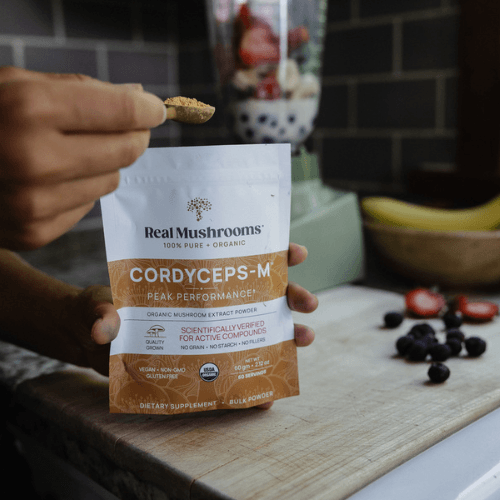
The ideal cordyceps dosage depends on several factors, including the form of cordyceps consumption, individual health status, and specific wellness goals. Cordyceps militaris can be available in various supplement forms, such as capsules, powders, and extracts, each with unique dosage guidelines.
Cordyceps supplements are often offered in doses ranging from 500 to 1,500 milligrams per day, depending on product formulation and intended use. Consult a healthcare provider to determine the appropriate amount for your needs. This dosage is typically divided into two or three smaller doses throughout the day to enhance absorption and maintain consistent levels in the bloodstream.
It is important to note that the dosage may need to be adjusted based on individual health conditions and responses.
For instance, individuals seeking to improve athletic performance might require a higher dosage within the recommended range, while those using Cordyceps for general wellness and overall health might opt for a lower dosage [3] [9].

Cordyceps mushrooms, while generally considered safe for most individuals, may cause certain side effects in some users.
These side effects are typically mild and may vary depending on the individual's health status, dosage, and duration of use. Common side effects associated with Cordyceps include:
The occurrence of side effects can be influenced by the quality and purity of the Cordyceps product being used.
When incorporating Cordyceps supplements into your routine, choosing high-quality supplements from reputable sources is essential to minimize the risk of adverse effects.
Additionally, lifestyle factors, such as diet and overall health, can also impact how your body responds to Cordyceps.
While Cordyceps mushrooms offer various health benefits, certain groups should avoid their use or seek medical advice to ensure safety. Individuals with autoimmune diseases, such as lupus, multiple sclerosis, or rheumatoid arthritis, may need to avoid Cordyceps, as it can potentially stimulate the immune system and exacerbate these conditions.
Pregnant or breastfeeding women are generally advised to avoid Cordyceps due to insufficient research on its safety in these populations. It is crucial for these individuals to consult with a healthcare provider before considering Cordyceps supplementation.
Individuals with known allergies to fungi or mold should avoid Cordyceps, as it may trigger allergic reactions. Those undergoing surgery should also refrain from using Cordyceps at least two weeks prior to the procedure, as it may affect blood clotting.
Rooted in Traditional Chinese Medicine, Cordyceps mushrooms are widely available as Cordyceps capsules, powders, and extracts, making them an easy addition to daily wellness routines.
The optimal health benefits of Cordyceps depend on factors like timing, dosage, and individual health goals. While some may prefer taking them in the morning for sustained energy, others integrate them with other supplements based on their needs.
Understanding the active compounds, potential interactions, and recommended dosages ensures you get the most out of your Cordyceps regimen.
Ready to experience the optimal benefits of Cordyceps mushrooms? Explore Real Mushrooms' range of organic, high-quality Cordyceps products today. Dive into a world of enhanced vitality and well-being—don't wait to transform your health journey!

The health of our skin is not just about appearance—it reflects overall well-being and serves as a crucial indicator of internal health. Factors such as environmental stressors, diet, hydration, and lifestyle choices significantly influence skin condition and may be the main cause of acne vulgaris. While many skincare products focus on external treatments, there is growing interest in natural solutions that support skin wellness from within. One such solution is the use of functional mushrooms. Natural Cordyceps mushrooms offer essential support for healthy skin and provide support for lessening acne breakouts.
Cordyceps has been utilized in Traditional Chinese Medicine (TCM) for centuries and is valued for its potential to support energy, vitality, and immune function. Recently, scientific interest has expanded to explore its role in skin health. This unique fungus contains bioactive compounds such as cordycepin and polysaccharides, which have been studied for their antioxidant and adaptogenic properties. Emerging research suggests that Cordyceps sinensis extracts may contribute to skin wellness by supporting hydration, resilience, and oxidative balance [2].
But how does Cordyceps fit into modern skincare and wellness routines? In this article, we will explore its potential benefits, research findings, and practical ways to incorporate it into daily life to support overall skin health.
Cordyceps is a genus of fungi, with Cordyceps sinensis extracts and Cordyceps militaris extracts being the most well-known species. Traditionally, Cordyceps was prized for its potential ability to support longevity, stamina, and overall well-being.
This fungus naturally grows in high-altitude regions and, in the wild, develops on insect larvae. Due to sustainability concerns and increased demand, most commercially available Cordyceps supplements are cultivated on plant-based substrates, making them more accessible and ethical.
Cordyceps extracts contain several important bioactive compounds that contribute to their potential wellness benefits. Cordycepin, a nucleoside, has been studied for its antioxidant properties, which may help protect skin cells [1]. Polysaccharides support immune function and oxidative balance, both of which are essential for skin resilience. Additionally, amino acids and peptides play a crucial role in maintaining skin structure and overall well-being. These compounds contribute to Cordyceps’ potential role in supporting skin hydration, maintaining a balanced complexion, and promoting overall vitality for all skin types.
Recent studies have explored the role of Cordyceps sinensis in modulating inflammatory responses, which is crucial for individuals with sensitive or reactive skin. A 2021 study published in Molecules found that extracts from Cordyceps sinensis could reduce inflammatory markers in human skin cells, suggesting potential benefits for conditions like eczema and psoriasis [1].
Furthermore, research in the International Journal of Molecular Sciences highlighted how cordycepin exhibits protective effects against UV-induced skin damage, making it a promising ingredient in anti-aging skincare formulations [2].

Cordyceps mushrooms, known for their adaptogenic and anti-inflammatory properties, as well as their antioxidant activity, can be beneficial for acne in several ways. One of the primary reasons acne may develop is due to excess sebum production and inflammation in the skin. Cordyceps contain bioactive compounds like polysaccharides, cordycepin, and antioxidants that support the regulation of the body's inflammatory response. By supporting a reduction in systemic inflammation, these mushrooms may help calm the redness and swelling commonly associated with acne breakouts.
Additionally, Cordyceps may also support the immune system, which plays a crucial role in healthy skin. Since acne is often triggered by bacterial overgrowth, particularly Propionibacterium acnes (now called Cutibacterium acnes), the antimicrobial properties of Cordyceps may help combat this bacteria and help lessen breakouts.
Another important way Cordyceps may help acne-prone skin is through its ability to support adrenal function and a healthy balance of hormones like cortisol. Since stress can be a major trigger for acne flare-ups, adaptogens like Cordyceps may help regulate the body's response to stress and minimize breakouts.
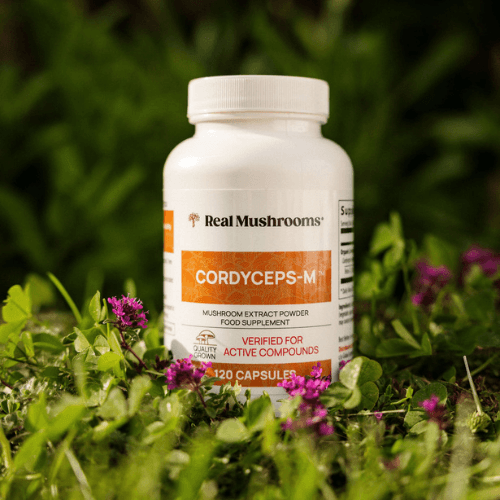
Cordyceps is available in various forms, including capsules, powders, and tinctures. Capsules offer a convenient way to incorporate Cordyceps into a daily wellness routine, while powders can be mixed into smoothies, teas, soups, or coffee. Tinctures provide liquid extracts that allow for fast absorption. To maximize benefits, consistency is key, as herbal supplements often work best with regular use.
Some skincare brands are beginning to incorporate Cordyceps extracts into their acne products due to their antioxidant properties. Serums or creams containing Cordyceps extract may help support skin hydration and barrier function, while face masks infused with mushroom-based antioxidants could provide an extra boost of nourishment. Herbal-infused facial oils may complement a natural skincare routine. Although research on the topical application of Cordyceps is still emerging, combining internal supplementation with external skincare may provide a comprehensive approach to wellness.
Cordyceps is generally well-tolerated, but it is important to consider certain precautions and side effects. Those with allergies to fungi should consult a healthcare provider before use. Individuals who are pregnant or breastfeeding should seek professional advice before incorporating Cordyceps into their routine.
Those taking immune-modulating drugs, blood thinners, or diabetes medication should consult a healthcare provider due to potential interactions. To ensure safety and efficacy, it is crucial to choose supplements from trusted brands with proper testing for purity and potency.
Cordyceps is a promising natural ingredient that may support overall wellness and help alleviate acne. Its antioxidant and adaptogenic properties may help the body manage oxidative stress and maintain balance, both of which contribute to skin vitality. While additional research is needed, incorporating oral Cordyceps into a holistic skincare approach—including a nutrient-rich diet, proper hydration, and stress management—may support a naturally radiant complexion.
As with any supplement, it is important to consult a healthcare professional before beginning a new regimen to ensure that it is appropriate for your individual needs.

Cordyceps is a genus of fungi that includes over 400 species, but Cordyceps militaris and Cordyceps sinensis are the most commonly researched varieties. These mushrooms are a mainstay of traditional Chinese medicine, as well as other alternative and complementary medicine. They grow naturally on insect larvae in high-altitude regions but are now cultivated on plant-based substrates to make them more accessible. Cordyceps contain bioactive compounds like cordycepin, adenosine, and polysaccharides, which researchers are investigating for their potential health-supporting properties, including peak power output during physical exertion [3].

Cordyceps militaris and sinensis have long been associated with energy enhancement and vitality in traditional medicine. In modern research, scientists are particularly interested in their effects on ATP production, oxygen utilization, adaptogenic properties, and their effect on human skeletal muscle and anaerobic performance [7]. While initial findings are promising, more studies are needed to fully validate their effectiveness for the growth of human skeletal muscle and athletic performance in conjunction with a normal diet and exercise routine [1].
Athletes, fitness enthusiasts, and sports science researchers often seek natural ways to optimize endurance, energy levels, and recovery, especially after high-intensity exercise. Some research suggests that cordyceps may help support VO2 max, a measure of how efficiently the body uses oxygen during exercise [5]. Improved muscle tissue oxygen saturation can contribute to sustained endurance and delayed fatigue, potentially enhancing performance in aerobic activities like running, cycling, and swimming. Increased oxygen uptake also benefits overall cardiovascular health [4].
Adenosine triphosphate (ATP) is the primary energy currency of cells. Cordyceps contain adenosine and cordycepin, which are being explored for their role in supporting ATP production [2]. More efficient energy production may help athletes sustain longer and more intense workouts. By helping the body utilize energy more effectively, cordyceps may support overall stamina and endurance [7]. Enhanced ATP production translates to improved muscle function. Since energy availability is one of the main factors in muscle contractions, optimizing ATP levels through supplementation could positively impact aerobic capacity, endurance capacity, resistance training, and high-intensity exercise [1].
Strenuous physical activity generates oxidative stress, which can contribute to muscle fatigue. The polysaccharides and other bioactive compounds in Cordyceps have been investigated for their antioxidant properties, which may help support the body’s natural recovery processes after exercise [3]. By supporting the body's ability to manage oxidative stress, cordyceps supplements may play a role in post-workout recovery [4].

The healthy growth of muscle requires consistent resistance training and proper recovery. By helping sustain energy levels and reduce perceived fatigue, Cordyceps extract may support individuals in maintaining regular workouts, which is essential for building muscle over time [1]. A supplement that supports endurance and reduces perceived effort can help individuals train longer and with greater intensity [5]. Preliminary research suggests that cordycepin, one of the active compounds in cordyceps, may play a role in cellular function. While more studies are needed on mushroom benefits, researchers are investigating its potential influence on muscle maintenance and repair [2]. Cellular health is essential for overall muscle function and recovery [6].
Cordyceps extract is often classified as an adaptogen, which means it may help the body adapt to physical and environmental stressors. Adaptogens have been studied for their potential to support energy balance and resilience to stress [4]. By supporting stress management, cordyceps may contribute to overall well-being, which is important for recovery and sustained physical performance (6).
Mitochondria, often referred to as the powerhouses of the cell, play a crucial role in energy metabolism. Efficient mitochondrial function is essential for endurance, muscle contraction, and post-exercise recovery. Some studies indicate that cordyceps may enhance mitochondrial efficiency, leading to improved cellular respiration and energy output. A study published in Molecules explored how Cordyceps supplementation influenced mitochondrial activity in skeletal muscle cells. The findings suggested that certain bioactive compounds in Cordyceps supplementation could help optimize mitochondrial function, potentially leading to enhanced stamina and endurance [1].
Healthy muscle development is dependent on protein synthesis—the process by which the body builds new muscle proteins. While protein intake from diet remains the most critical factor, certain compounds in cordyceps may influence protein metabolism [2]. A study published in Food & Function investigated the effects of cordycepin, one of the key bioactive compounds in cordyceps, on protein synthesis pathways. The research suggested that cordycepin may help regulate signaling pathways associated with muscle repair and maintenance [3].

Several studies have explored the potential benefits of cordyceps on physical performance. A study published in the Journal of Dietary Supplements found that individuals supplementing with cordyceps experienced improvements in exercise performance compared to a placebo group [1]. Research in Frontiers in Pharmacology highlighted cordyceps' antioxidant properties, suggesting they may support the body’s response to oxidative stress from intense exercise [2].
Cordyceps have gained attention for their potential role in supporting endurance performance, energy, and recovery—key factors that contribute to muscle development and a healthy body mass index [4]. While more research is needed to fully understand their benefits, current studies suggest that cordyceps supplementation may be a valuable addition to a well-rounded fitness and nutrition plan [1].
As with any supplement, consistency, proper training, and balanced nutrition remain the most important factors for achieving overall performance goals. If you are considering cordyceps for athletic support, consult with a healthcare professional to determine whether they align with your individual health and fitness goals. By taking a holistic approach to training and wellness, you can optimize your potential for strength, endurance, recovery, and a healthy body weight.

With the return of The Last of Us Season 2, audiences are once again captivated by the unsettling idea of a fungus that doesn't just control minds—it completely takes over its host, reshaping biology and behavior. While human Cordyceps zombies remain the stuff of fiction, in the insect world, they are a reality, where the fungus hijacks its host’s behavior to ensure its survival.
Thankfully, Cordyceps plays an entirely different role in humans. Rather than overtaking its host, it works in harmony with the body to support energy, immune function, and metabolic processes—key aspects of maintaining overall well-being. Once a treasured mushroom in traditional medicine systems, it is now at the forefront of scientific research, with studies beginning to confirm its diverse health benefits.
With over 35 years in the herbal medicine industry—blending traditional botanical wisdom with cutting-edge biomedical science—I’ve dedicated my career to understanding how functional mushrooms, herbs, and adaptogens fit into modern wellness. As a practitioner, my clinical experience has shown me firsthand how Cordyceps militaris can optimize vitality, endurance, and long-term health.
As spring ushers in a season of renewal and vitality, Cordyceps militaris stands out as a natural choice for sustained energy, endurance, and overall performance. Long celebrated for its ability to support resilience and metabolic health, it’s the perfect complement to a time of fresh starts and revitalization. Building on this understanding, let’s explore the history, clinical research, and real-world applications of this remarkable fungus—helping you feel your best this season and beyond.
Traditionally, Cordyceps has been classified as a tonic in Traditional Chinese Medicine (TCM), revered for its ability to enhance vitality, restore strength, and nourish Jing (life essence). It was primarily used to fortify the lungs, kidneys, and immune system, supporting endurance, longevity, and overall resilience [13].
The term tonic has a long history across various traditional healing systems, though it has fallen out of favor in modern scientific discussion due to its broad and somewhat ambiguous definition. However, in my clinical practice, I use tonic to describe substances that enhance the tone, vigor, and function of a specific organ, a bodily system, or the body as a whole, promoting sustained well-being and energy over time [1] [5]. In this context, Cordyceps militaris exemplifies a classic tonic, supporting overall vitality and resilience in a way that aligns with both traditional use and modern scientific understanding.
From a modern perspective, Cordyceps militaris also exhibits adaptogen-like properties, particularly in its ability to help the body adjust to stress and maintain balance. Adaptogens are known for their ability to support resilience through regulating stress response systems, including the neuroendocrine-immune network. Research suggests that C. militaris contributes to this process by influencing mitochondrial function, energy metabolism, and cellular signaling pathways that help the body adapt to physical and environmental stressors [18].
It is important to note that the concepts of tonic and adaptogen are not mutually exclusive. In my training, herbs and mushrooms often have multiple physiological actions, meaning a single substance can both strengthen the body over time and enhance its ability to adapt to stress.
While tonics are traditionally seen as nourishing and restorative, adaptogens specifically help regulate the body’s response to stress. Cordyceps militaris embodies both roles—rooted in ancient tradition while increasingly recognized for its ability to support resilience and overall well-being.
Cordyceps has played a prominent role in Traditional Chinese and Tibetan Medicine, where it has been used to support:
These traditional uses were based on centuries of observation and practice. Today, scientific research continues to explore and validate these applications, shedding new light on the mechanisms behind Cordyceps’ historical reputation [4] [16].
Cordyceps militaris (CM) has emerged as the preferred species due to its accessibility, sustainability, and superior bioactive profile. Unlike other species, CM can be cultivated on plant-based substrates such as brown rice, eliminating the ethical and environmental concerns associated with harvesting wild fungi.
A crucial distinction sets CM apart: It is naturally rich in cordycepin (3'-deoxyadenosine), a bioactive nucleoside absent in Ophiocordyceps sinensis [2]. Cordycepin is actively being studied for its potential to support metabolic processes, healthy inflammatory responses, and physical endurance. Over 1,500 scientific papers have been published on cordycepin, highlighting its broad therapeutic potential.
By offering a sustainable and equally effective alternative, CM is the clear choice for those looking to harness the full potential of Cordyceps without the limitations of traditional sources.
While traditional knowledge provides a strong foundation, modern science increasingly supports CM as the superior option. Recent clinical studies highlight the potential health benefits of CM, particularly its effects on:
Potential & Emerging Uses

Cordyceps contains two primary categories of bioactive compounds:
Cordycepin (3'-deoxyadenosine) is a rare compound found only in Cordyceps militaris. It closely resembles adenosine—a key nucleoside and fundamental building block involved in energy production (the “A” in ATP), RNA synthesis, and cellular signaling.
RNA (ribonucleic acid) is a molecule that helps cells read genetic instructions from DNA and build the proteins they need to function. It plays a crucial role in everything from energy metabolism to repairing cells.
Because cordycepin mimics adenosine, it can fine-tune —or even redirect—RNA-related processes in a way that helps regulate:
This ability to modulate RNA activity makes cordycepin a fascinating compound—not a zombie-inducing molecule, but a true biological and metabolic regulator.
For those interested in the deeper biological mechanisms at play, here’s a simplified breakdown of cordycepin, that standout compound in Cordyceps militaris:
This section is for the super nerdy and those who love diving into the deeper biological mechanisms at play. If that’s not you, feel free to skip ahead!
The biohacking community has been buzzing about pentostatin, an adenosine deaminase (ADA) inhibitor found in CM that could theoretically extend the bioactive effects of cordycepin. In the CM fungus, pentostatin protects cordycepin from being broken down. Some researchers have hypothesized —despite a lack of human studies—that it could slow cordycepin breakdown in humans, potentially amplifying its endurance and recovery benefits. However, the recent research on 3DI —the precursor to intracellular cordycepin—as discussed above, has debunked this idea. Nature already provides the best solution [4] [19]!
As spring rejuvenates nature, our bodies also seek renewal—supporting energy, resilience, and immune strength. Cordyceps militaris aligns perfectly with this seasonal shift, supporting endurance, immunity, and optimizing metabolic function. Whether you're an athlete, a busy professional, or simply looking to sustain vitality, integrating CM into your routine this season can set the foundation for long-term well-being
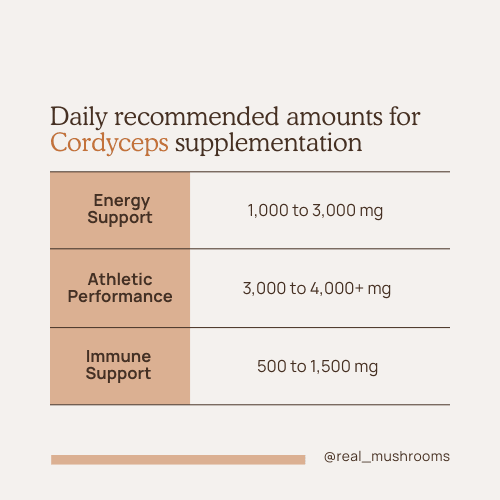
The optimal daily amount of Cordyceps varies based on individual needs and desired benefits. Starting with a lower dose and gradually increasing is recommended. For energy support, higher daily amounts may be required.
Many commercial “Cordyceps” supplements are made using mycelium fermented grains like brown rice and oats, rather than the actual mushroom (fruiting body). This results in a product with a high starch content and significantly lower levels of bioactive compounds, including beta-glucans and cordycepin [10]. In contrast, mushroom (fruiting body) extracts contain the highest concentrations of these beneficial compounds.
Additionally, some product labels list cordycepic acid, which can be misleading. Cordycepic acid is not the same as cordycepin—it is an outdated term for mannitol, a common sugar found in most mushrooms. Companies that highlight cordycepic acid may be attempting to create the false impression that their product contains cordycepin.
It's also worth noting that Cordyceps sinensis products do not contain cordycepin, further reinforcing why CM is the superior choice.
The real-world science of Cordyceps militaris is just as compelling as the fiction of The Last of Us. While it won’t turn you into a fungal zombie, its unique components support natural biological processes related to metabolism, immune health, and cellular function, offering a powerful way to promote overall well-being.
As you step into spring, take your energy and resilience to the next level with Cordyceps! Experience the scientifically backed benefits of C. militaris—boosting endurance, strengthening immunity, and optimizing metabolic health for lasting vitality.
By combining ancient tradition with cutting-edge research, Cordyceps militaris is more than just a seasonal booster—it’s a lifelong ally for health and vitality.

Mushrooms have been valued for centuries in traditional medicine and as functional foods because of their potential health benefits, and two of the most popular varieties today are Cordyceps and Lion’s Mane. These functional mushrooms have distinct properties, potential wellness benefits, and unique compounds that make them stand out.
While cordyceps mushrooms are often associated with energy, endurance, and respiratory health, the lion’s mane mushroom is linked to cognitive support and nervous system health. This article provides a detailed comparison of these two remarkable fungi, their traditional uses, research-backed properties, and how they can be incorporated into wellness routines for maximum health benefits.

Cordyceps is a genus of parasitic fungi that grows on insect larvae, particularly in high-altitude regions such as the Himalayas. The two primary species used in supplements are Cordyceps sinensis (Ophiocordyceps sinensis) and Cordyceps militaris. The former was traditionally harvested in the wild and is now difficult to source due to conservation concerns. The latter is more commonly cultivated and studied due to its high concentration of active compounds, particularly cordycepin. In Traditional Chinese Medicine (TCM), Cordyceps has long been used to support stamina, energy levels, and lung function.
Lion’s Mane (Hericium erinaceus) is a white, shaggy mushroom that resembles a lion’s mane as it grows. It is found on hardwood trees in North America, Europe, and Asia. Unlike Cordyceps, Lion’s Mane is not parasitic but rather a saprophytic fungus, meaning it grows on decaying wood. This mushroom has been widely studied for its potential to support brain health, memory, mood, and nervous system regeneration. It has been used in traditional medicine in China and Japan for centuries as a tonic for the brain and gut, among other health benefits.
Cordyceps contains several bioactive compounds that contribute to its health benefits. Among these, cordycepin is a unique nucleoside that has been studied for its potential anti-inflammatory and energy-supporting properties. Adenosine, another compound, plays a role in ATP (energy) production in the body, potentially explaining Cordyceps’ historical use for vitality and endurance. Additionally, Cordyceps contains polysaccharides, which may contribute to immune modulation and antioxidant activity.
On the other hand, the Lion’s Mane mushroom is rich in compounds known as hericenones and erinacines, which may support nerve growth factor (NGF) synthesis. Hericenones are found in the fruiting body and are believed to support cognitive function, while erinacines are found in the mycelium and studied for their potential neuroprotective effects. Like Cordyceps, the Lion’s Mane mushroom also contains polysaccharides and beta-glucans, which may support immune health and antioxidant activity.
Cordyceps may support ATP production, the body’s main energy currency, making it a favorite among athletes and fitness enthusiasts. Research has explored its role in supporting endurance and oxygen utilization in the body. Beyond performance, Cordyceps has been traditionally used in TCM to support overall vitality, including respiratory function. Additionally, Cordyceps may support energy levels and endurance, as some research suggests it may support post-exercise recovery and energy levels.
Lion’s Mane is often associated with cognitive support and maintaining a healthy nervous system. It may play a role in supporting cognitive health. The presence of erinacines and hericenones suggests they may support nerve function and overall neurological health. Additionally, the Lion’s Mane mushroom may provide mood support, with a possible role in emotional well-being and stress resilience. Lion’s Mane may also act as a potential tool for supporting healthy sleep quality, making it an interesting option for those struggling with occasional sleep disturbances.

The cordyceps mushroom has a long history of use in Traditional Chinese Medicine, where it has been used as a tonic for vitality, kidney health, and respiratory support. Modern applications include its use in healthy pre-workout supplements, energy tonics, and respiratory health formulas. The cultivation of Cordyceps militaris has made it more widely accessible, and it is now commonly included in various wellness products.
The Lion’s Mane mushroom has been used in East Asian food and medicine for digestive health, immune system support, skin health, and brain function. Today, it is a popular ingredient in supplements that support cognitive function, functional beverages, and powdered extracts for brain health support. Unlike Cordyceps, Lion’s Mane is also enjoyed in culinary applications, as it has a mild, seafood-like flavor and a meaty texture that works well in vegetarian food.

Both Cordyceps and Lion’s Mane are available in various forms, including capsules, powders, tinctures, and even whole mushrooms in the case of Lion’s Mane. Capsules are a convenient way to ensure consistent dosing, while powders can be mixed into smoothies, coffee, or tea. Tinctures, which are alcohol or water extracts, may provide faster absorption.
Cordyceps is often taken in the morning or before exercise to support healthy energy levels. Lion’s Mane, depending on individual preference, may be taken in the morning for focus or in the evening for potential relaxation benefits. Some users find that taking Lion’s Mane before bed supports deep sleep, thanks to its possible influence on the nervous system.

Both Cordyceps and Lion’s Mane are generally considered safe for most people when consumed in appropriate amounts. However, Cordyceps may interact with medications affecting immune function and blood clotting. Lion’s Mane may cause mild digestive discomfort in some individuals. Additionally, it may help slightly lower blood sugar levels, which could be a consideration for those with diabetes or blood sugar concerns. As always, those with mushroom allergies or taking prescription medications should consult a healthcare provider before using these supplements.

While both mushrooms offer unique benefits, their primary applications are distinct. Cordyceps is most often used for energy, stamina, and physical endurance, while Lion’s Mane is known for its cognitive function and nervous system support. For those looking to optimize physical performance, Cordyceps may be the better option, whereas individuals seeking enhanced memory, focus, and mood support may find the Lion’s Mane mushroom more beneficial. Understanding their differences allows for better integration into individual wellness routines.
Cordyceps and Lion’s Mane mushrooms each offer unique potential benefits and applications. If you’re looking to support energy, endurance, and physical performance, Cordyceps might be the better choice. If cognitive function and nervous system health are your focus, then Lion’s Mane could be more suitable.
As with all dietary supplements, it’s best to choose high-quality mushroom supplements from reputable sources and consult a healthcare professional before making significant changes to your wellness routine.

In today’s fast-paced world, maintaining consistent energy levels is a priority for many. Whether it’s to support endurance exercise, enhance cognitive function, or help sustain overall vitality, individuals are increasingly exploring natural solutions. One such ingredient gaining attention is Cordyceps, a unique type of fungus traditionally used in herbal wellness practices, especially in eastern medical practices.
Cordyceps has a long history in traditional Chinese medicine and other Eastern medical practices, where it has been associated with vitality and longevity. While modern research is still evolving, preliminary studies suggest that Cordyceps may play a role in supporting energy metabolism, oxygen utilization, and physical endurance. This article will explore how Cordyceps may help maintain energy levels, support performance, and high-intensity exercise, promote overall well-being, and help lessen the feeling of physical fatigue.
Cordyceps is a genus of fungi with over 700 identified species, but the most widely studied for wellness applications are Cordyceps sinensis and Cordyceps militaris. These fungi grow naturally in high-altitude regions and have been traditionally used in ancient Chinese herbal medicine.
While wild Cordyceps sinensis is rare and expensive, Cordyceps militaris is widely cultivated and used in dietary supplements. Both varieties contain antioxidants that may support cellular energy, and oxygen uptake, thereby helping to improve endurance exercise performance.

Energy production in the body occurs at the cellular level, where mitochondria generate adenosine triphosphate (ATP)—the primary energy carrier for cells. ATP fuels all biological processes, from muscle contractions to brain function. It also may provide other health benefits.
Cordyceps contains nucleosides such as cordycepin, which resembles adenosine, a key building block of ATP. Research suggests that Cordyceps may help support ATP synthesis, potentially playing a role in maintaining energy, endurance, and good health.
Emerging research suggests that Cordyceps may provide numerous health benefits, including support for healthy ATP production, thereby contributing to energy metabolism. A study published in Frontiers in Pharmacology (2020) explored the effects of the cordyceps fungus on mitochondrial function (1). Researchers found that certain bioactive compounds in Cordyceps may promote mitochondrial efficiency, which could play a role in energy production and muscle performance and provide other potential health benefits. Furthermore, Cordyceps has been observed to support the body’s natural oxygen utilization, which is essential for aerobic endurance and sustained energy levels.
Key Takeaway: Cordyceps supplements may help support ATP production, which plays a role in maintaining cellular energy and physical and aerobic performance.
Cordyceps is often used in athletic communities due to its potential effects on oxygen utilization and stamina in the human body during and after athletic performance.
A randomized, double-blind study published in The Journal of Dietary Supplements (2016) examined the effects of Cordyceps militaris supplements on exercise performance (2). The study found that participants who took 4 grams of Cordyceps daily for three weeks experienced a notable improvement in VO2 max, a measure of the body's ability to use oxygen during exercise.
Similarly, a 2014 study in The Journal of Alternative and Complementary Medicine suggested that older adults who consumed 1 gram of Cordyceps sinensis daily for 12 weeks reported improved exercise tolerance and overall vitality (3).
Key Takeaway: Cordyceps benefits may include support oxygen efficiency and endurance, which can contribute to sustained energy during physical activity and may also support overall good health.

Fatigue is a common concern, affecting both physical and mental performance. Cordyceps may support post-exercise recovery and help sustain natural energy levels through several mechanisms:
During intense physical exertion, lactic acid builds up in the muscles, leading to fatigue and soreness. Some research suggests that Cordyceps may support the body’s natural process of lactate clearance, helping maintain muscle performance.
Cordyceps is thought to promote erythropoietin (EPO) production, a hormone involved in red blood cell formation. More red blood cells may help transport oxygen efficiently, supporting stamina and post-exercise recovery. Studies indicate that Cordyceps contains antioxidant compounds that may support healthy inflammation response and help support normal recovery processes by neutralizing oxidative stress (4).
Key Takeaway: Cordyceps may play a role in supporting normal post-exercise recovery, maintaining physical performance, and supporting human health.
Beyond its role in energy support, genus cordyceps contains bioactive compounds that may contribute to overall well-being.
Cordyceps contains polysaccharides and beta-glucans, compounds that are believed to help support the body's natural immune function and provide support via bioactive compounds. By supporting healthy immune responses, using Cordyceps for energy may contribute to overall wellness and resilience. While more research is needed, some studies suggest that Cordyceps may help support cognitive function, potentially due to its role in oxygen utilization and cellular metabolism.
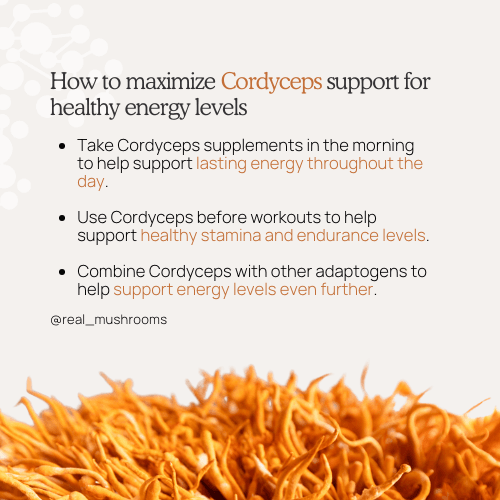
Cordyceps supplements are commonly available in capsule, powder, or extract form.
While individual needs may vary, most studies suggest an effective daily dose of 1–4 grams of Cordyceps extract for most people.
To maximize potential benefits:
Cordyceps is generally well-tolerated, but there are some individuals who may experience a mild level of digestive discomfort. Be sure to avoid chronic supplementation. If you are pregnant, nursing, or taking medications, consult a healthcare professional before use.
While existing clinical studies are promising, more large-scale human trials are needed to further explore the long-term benefits of Cordyceps. Future research should focus on:
Cordyceps has been traditionally used to help support stamina and endurance. While emerging research suggests that Cordyceps may play a role in energy metabolism and oxygen utilization, more studies are needed to fully understand its long-term benefits.
Summary of Potential Benefits:
If you're looking for a natural way to help support vitality, Cordyceps may be a valuable addition to your wellness routine.
These statements have not been evaluated by the Food and Drug Administration. This product is not intended to diagnose, treat, cure, or prevent any disease.

Cordyceps mushrooms, particularly Cordyceps sinensis and Cordyceps militaris, are functional mushrooms known for their potential health benefits and historical use in traditional Chinese medicine to enhance energy, stamina, and overall vitality.
In recent years, scientific interest in the cordyceps fungus has grown, with animal and lab studies exploring its effects on various aspects of human health, including immune function, respiratory health, and mental well-being. As a result, natural cordyceps supplements have gained popularity as a form of alternative medicine.
In traditional Chinese medicine, cordyceps were often prescribed to support fatigue and respiratory troubles and to promote overall well-being. The fungi were believed to support the immune system, energy levels, and healthy respiratory function.
Often combined with other Chinese herbs like Rhodiola rosea and reishi mushroom (Ganoderma lucidum), cordyceps were valued for their bidirectional regulatory effects on the human body. This means they could both enhance or suppress certain bodily functions as needed, helping to restore balance, improve energy, and support overall health and adaptability.
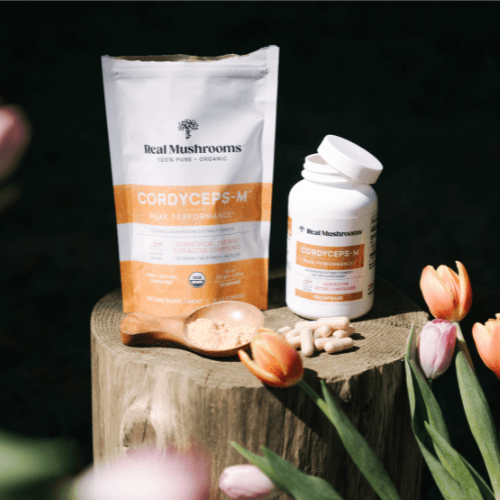
Cordyceps mushrooms may support energy metabolism and endurance, making them popular among athletes looking to enhance exercise performance.
Studies suggest that cordyceps can help support oxygen utilization and blood flow, healthy inflammation response, and whole-body insulin sensitivity, potentially leading to better endurance during high-intensity exercise. [2] [3] [4]
“When you’re exercising, you’re causing inflammation throughout your body. By decreasing that, you’re going to perform much better.”
- Registered dietitian Beth Czerwony, Cleveland Clinic
Cordyceps contains compounds that may assist the body in maintaining a balanced response to physical exertion. Notably, cordycepin has been recognized as a potential nutraceutical.
The effects of cordyceps on ATP production may help improve the efficiency of energy utilization in the body, particularly beneficial for those engaging in prolonged physical activity.

Research indicates that cordyceps may have potential benefits for respiratory health. Cordyceps may help support respiratory function, including normal oxygen uptake and lung health. In traditional Chinese medicine, it is traditionally used to support lung health and respiratory function. [5]
The active compounds in cordyceps, such as cordycepin, are believed to play a role in these effects. While more research is needed, preliminary studies suggest that cordyceps may support normal respiratory function and oxygen utilization. [6]
Cordyceps are believed to contain bioactive compounds that may contribute to their immunomodulatory effects. Cordyceps may help support a balanced immune response.
These bioactive compounds are believed to play a key role in modulating immune functions and supporting the body in maintaining a balanced defense system. While more research is needed, the preliminary findings are promising for those seeking natural support for their immune health. [7]
Cordyceps mushrooms may help maintain cardiovascular function and support normal cholesterol levels already within a healthy range.
Additionally, Compounds in cordyceps may support healthy circulation and normal blood flow.
The antioxidant properties of cordyceps may support heart health through antioxidant activity. By mitigating oxidative damage, cordyceps may help preserve the integrity of heart tissues and potentially assist in enhancing cardiovascular health. [3]
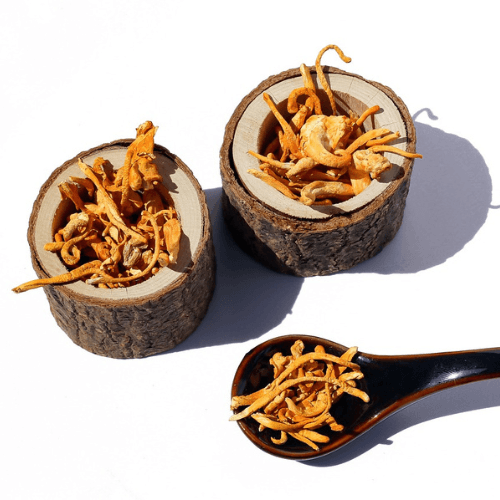
Cordyceps mushrooms may support a healthy stress response and support cognitive wellness. As adaptogens, they may support the body in achieving homeostasis during stressful situations. Specific preclinical studies shed more light on their effects.
Research published in the International Journal of Medicinal Mushrooms (2020) revealed that mice given Cordyceps militaris extract exhibited decreased anxiety-like behaviors when exposed to stress-inducing maze tests, highlighting its potential influence on stress-related behavior. Additionally, in rodent models undergoing doxorubicin chemotherapy, Cordyceps militaris extract was found to mitigate oxidative stress caused by the treatment. [8]
Another study examined the effects of combining Cordyceps militaris and Armillaria mellea on low mood. After 28 days of treatment, the formula was shown to support a reduction in stress-related behaviors in rats, including loss of pleasure and low activity levels. It helped restore balance in brain chemicals like serotonin and dopamine, lowered stress hormone levels, and reduced inflammation in the brain by calming overactive immune cells. [9]
These results suggest that Cordyceps mushrooms may help the body adapt to occasional stress and support emotional well-being.
Cordyceps also have the potential to improve cognitive function. Their antioxidant and neuroprotective properties may support brain health and enhance cognitive abilities. By modulating neurotransmitter levels, cordyceps may support cognitive function, including focus and mental clarity.

Research suggests that cordyceps may support the body's normal inflammatory response and overall liver and kidney function. [10] [11]
When considering taking cordyceps supplements, it's essential to consult with a healthcare provider, especially for individuals with bleeding disorders or those taking blood thinners. The proper intake amounts and potential interactions with other medications should be carefully considered. While cordyceps are generally considered safe, some people may experience allergic reactions or other side effects.
While cordyceps mushrooms show promise in various aspects of human health, from supporting the immune system to supporting exercise performance, more research is needed to fully understand their effects and establish standardized guidelines for their use.
Incorporating cordyceps into a recovery regimen can be done through various forms, including powders, capsules, and extracts. The choice of form may depend on personal preference and specific health goals.
Discover the natural support of Cordyceps for your wellness journey. Don't miss out on the chance to support your vitality and well-being—explore our premium cordyceps products today and feel the difference.
Act now and elevate your health journey with the purest mushroom supplements available!

Cordyceps mushrooms, a type of parasitic fungus used in ancient Chinese herbal medicine for centuries, have gained popularity due to their potential health benefits. However, like any supplement, cordyceps mushrooms may cause side effects in some individuals. Understanding these potential side effects is crucial for consumers to make informed decisions about their use.
This article explores the possible side effects associated with cordyceps mushrooms, addressing common concerns and providing insights into their safety profile.
While cordyceps mushrooms offer numerous health benefits, some individuals may experience mild digestive discomfort. Being aware of these side effects helps ensure safe usage.
Cordyceps mushrooms, including natural Cordyceps sinensis and Cordyceps militaris, have been traditionally used in various forms of Chinese traditional herbal medicines, with perceived health-improving properties. However, like many supplements, they may cause digestive issues in some individuals.
The most commonly reported digestive side effects include nausea, diarrhea, and stomach cramps. These symptoms can vary in intensity and duration, depending on the individual's sensitivity and the dosage consumed. [1]
Consuming the mushrooms with food may also help prevent gastrointestinal discomfort. Additionally, staying hydrated and monitoring one's diet can further alleviate symptoms.
Tip: To mitigate digestive issues, it is recommended to start with a low dose of cordyceps and gradually increase it, allowing the body to adjust.
Cordyceps mushrooms are often associated with increased energy levels and better athletic performance, which has led to their popularity as a natural Cordyceps supplement.
The active compounds in cordyceps, such as cordycepin, are believed to play a role in boosting energy by improving the efficiency of oxygen utilization and increasing ATP production, the primary energy carrier in cells. This effect can potentially lead to heightened stamina and reduced fatigue, making cordyceps a favored choice among athletes and individuals seeking to improve endurance exercise performance. [2]
However, the impact of cordyceps on sleep patterns is less straightforward. While some users report increased alertness and energy, others may experience disturbances in their sleep cycle.
To mitigate potential sleep disturbances, it is generally recommended to consume cordyceps earlier in the day. This timing allows the body to utilize the energy-supporting effects during waking hours and reduces the likelihood of interference with nighttime rest.
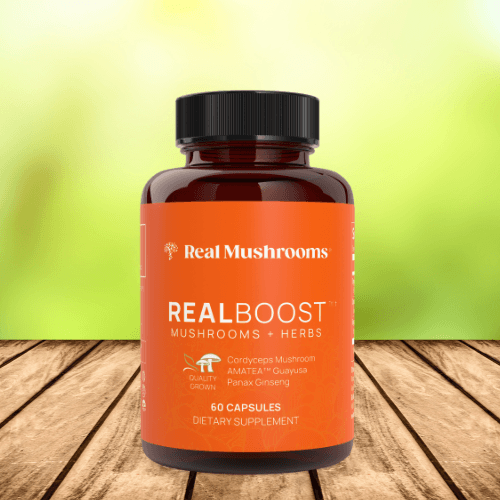
Cordyceps mushrooms are generally considered safe when used in moderation, but questions remain about their long-term effects. Understanding the potential risks associated with prolonged use is essential for making informed decisions about supplementation.
Cordyceps mushrooms have been studied for their potential assistance in maintaining normal blood sugar levels. These fungi are believed to influence glucose metabolism, which may benefit individuals seeking to regulate their blood sugar.
The primary mechanism by which cordyceps may affect blood sugar involves the support of insulin sensitivity and the modulation of glucose uptake in cells.
Research indicates that cordyceps may support healthy glucose metabolism and insulin function, as observed in preliminary studies, thereby improving the body's ability to utilize glucose efficiently.
This effect is particularly relevant for individuals with insulin resistance. Additionally, cordyceps are thought to stimulate the production of insulin by the pancreas, further aiding in the regulation of blood sugar levels. [3] [4]
The effects of cordyceps on blood sugar can vary based on dosage and individual health status. Individuals with insulin resistance should monitor their blood sugar levels closely and consult a healthcare professional before incorporating cordyceps into their regimen.
Health Tip: Maintain normal blood sugar by eating balanced meals with complex carbohydrates, lean protein, and healthy fats. Regular physical activity also helps improve insulin sensitivity and glucose control.
While some studies suggest that cordyceps have been traditionally used to support cardiovascular function, and research suggests they may contribute to healthy circulation, there are also concerns about potential side effects.
One of the primary cardiovascular concerns associated with cordyceps mushrooms is their impact on blood pressure. Cordyceps has been studied for its potential role in supporting cardiovascular function and circulation. Individuals with blood pressure concerns should speak with their healthcare provider.
The impact on blood pressure could be beneficial for individuals with hypertension; however, it may pose risks for those with already low blood pressure or those taking medications that lower blood pressure, potentially leading to hypotension. [5] [6]
While this could be advantageous for some individuals, it may also interact with medications used to treat arrhythmias or blood thinners, necessitating caution and consultation with a healthcare provider.

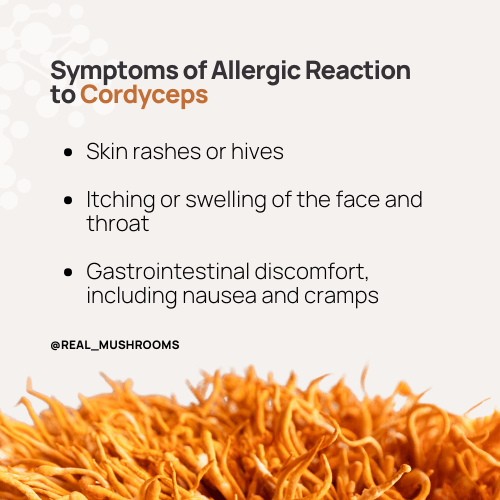
While allergic reactions to cordyceps mushrooms are considered relatively uncommon, they can occur in susceptible individuals.
The prevalence of such reactions is not well-documented in scientific literature, largely due to the limited number of studies specifically addressing the allergenic potential of cordyceps. However, as with any natural supplement, individual responses can vary significantly.
Symptoms of an allergic reaction to cordyceps can include:
Due to the potential for serious allergic reactions, it is advisable for individuals with known sensitivities to fungi to exercise caution when considering the use of cordyceps supplements. Healthcare providers may recommend starting with a small dose to monitor for any adverse reactions.
Cordyceps mushrooms, like many supplements, have the potential to interact with various medications, leading to a range of consequences. These interactions can alter the effectiveness of medications or exacerbate side effects, posing risks to individuals who are concurrently using pharmaceuticals.
One of the primary concerns is the interaction of cordyceps with immunosuppressive drugs. Cordyceps have been studied for their role in supporting immune function, but individuals taking immunosuppressive medications should consult their healthcare provider. Cordyceps may be supportive when used in organ transplant patients or individuals with autoimmune diseases like systemic lupus erythematosus. This antagonistic interaction could potentially lead to reduced efficacy of the immunosuppressive therapy. [7]
Additionally, cordyceps may interact with anticoagulants or antiplatelet medications. The potential for cordyceps to affect blood clotting mechanisms could enhance the effects of these medications, increasing the risk of bleeding complications.
Patients taking blood thinners such as warfarin, aspirin, or other blood-thinning agents should be particularly cautious and consult healthcare providers before incorporating cordyceps into their regimen.
Cordyceps may also influence the metabolism of certain drugs by affecting liver enzymes responsible for drug breakdown. This can lead to altered plasma levels of medications, either increasing the risk of toxicity or reducing therapeutic efficacy. [8]
Research on the safety of cordyceps mushrooms during pregnancy and breastfeeding is limited, and there is a lack of comprehensive clinical studies specifically addressing this topic. The primary concern with the use of cordyceps during pregnancy and breastfeeding is the potential transfer of bioactive compounds, which could affect the fetus or infant.
Given these uncertainties, healthcare professionals often advise pregnant and breastfeeding women to exercise caution and avoid the use of cordyceps unless specifically recommended by a healthcare provider. It is essential for pregnant women to consult with their healthcare providers before taking any supplements, including cordyceps, to ensure the safety of both the mother and the developing fetus.
Health Tip: Pregnant women should prioritize a nutrient-rich diet, stay hydrated, and get adequate rest to support their health and the baby’s development. Always consult a doctor before taking any supplements or making major dietary changes.
Like many supplements, taking Cordyceps in high amounts may lead to mild digestive discomfort in some individuals. It is advisable to follow recommended dosage guidelines and consult a healthcare provider if unsure. While cordyceps are generally considered safe when consumed in moderate amounts, high doses may result in adverse reactions.
Some of the side effects associated with excessive intake of cordyceps include:
It is important for individuals considering the use of cordyceps mushrooms to adhere to recommended dosages and consult healthcare professionals, especially if they have underlying health conditions or are taking other medications. Monitoring for any adverse effects and adjusting intake accordingly can help mitigate the risks associated with excessive consumption.
While cordyceps mushrooms are generally considered safe for most individuals, they may cause a range of side effects, including digestive issues, changes in energy levels and sleep patterns, and potential allergic reactions. Long-term effects and interactions with medications, particularly concerning blood sugar and cardiovascular health, warrant caution.
Understanding these potential side effects can help users make informed decisions about incorporating cordyceps mushrooms into their health regimen.
Ready to experience the natural energy and vitality of Cordyceps without the worry of side effects? Explore Real Mushrooms' premium selection, crafted from 100% mushrooms (fruiting body), and feel the difference today.


The Cordyceps fungus, also known as the "zombie fungus," is one of nature's most remarkable creations. Famous for its ability to infect and control the behavior of insects, Cordyceps offers a glimpse into the extraordinary complexities of the natural world.
Beyond its eerie life cycle, the fungus has made a name for itself in traditional medicine and modern supplements, celebrated for its purported health benefits.
Let’s explore how this fascinating organism operates, its role in ecosystems, and its growing use in the wellness industry.
Cordyceps is a genus of fungi comprising over 400 species [1], uniquely characterized by their parasitic ability to hijack the bodies of insects. These fungal species infiltrate their hosts—such as carpenter ants, caterpillars, or beetles—by attaching fungal spores to the insect’s exoskeleton and penetrating its body.
Once inside, this parasitic fungus commandeers the host’s central nervous system, eventually steering its behavior. In a remarkable feat of biological control, the infected insect is driven to climb to an elevated position, ideal for spore dispersal when the fungus later emerges.
This chilling survival strategy has made Cordyceps a subject of both scientific fascination and ecological importance. By regulating insect populations [2], the fungus prevents overpopulation that could destabilize ecosystems and overconsume resources.
Interestingly, the significance of Cordyceps extends beyond its macabre life cycle. In Himalayan cultures, some species have been prized for centuries as natural remedies for enhancing vitality and endurance. Today, the fungus is not only a marvel of nature but also a valuable resource in traditional medicine and modern health supplements.
With hundreds of identified species of Cordyceps, at least 35 are recognized for their potential health benefits and medicinal properties. Among these, a few stand out for their unique biology and uses. Let’s take a closer look.
Native to the Tibetan Plateau, this unique fungus has been traditionally used in herbal practices. Known as the 'caterpillar fungus' due to its natural symbiosis with caterpillars, it has been valued for its role in supporting vitality, endurance, and overall well-being.

Unlike Ophiocordyceps sinensis, Cordyceps militaris can be sustainably cultivated without reliance on insect hosts [3]. Its vibrant orange fruiting body is often featured in functional mushroom supplements, offering a cost-effective and eco-friendly alternative.

Also known as the “zombie ant fungus,” this species may produce bioactive compounds like red naphthoquinones with potential anti-malarial properties [4]. Famous for its mind-control abilities, it compels the infected ants to climb vegetation for optimal spore dispersal.
Beyond its chilling behavior, this fungus showcases the ecological significance [5] and biotechnological potential [6] of Cordyceps.
The zombie-like behavior Cordyceps triggers in its hosts is a masterstroke of evolutionary adaptation. By releasing targeted enzymes and chemical compounds, the fungus overrides the insect's behavior.
Ophiocordyceps unilateralis fungus infects an ant’s behavior, directing the infected ant to climb a plant stalk and clamp onto it in a “death grip” [7] This ensures the fungus's fruiting body will grow in an advantageous location for fungal spore dispersal.
Over time, the fungus consumes the insect from the inside, using it as a living incubator before completing its reproductive cycle. The methodical precision of this process has fascinated scientists and inspired popular media, from novels like “The Girl With All the Gifts” to the video game (and TV series) “The Last of Us”.
No, Cordyceps cannot control or infect humans or the human body. Its mechanisms for parasitism are strictly species-specific, finely tuned to the biology of its insect hosts over millions of years.
Humans lack the biochemical pathways that the parasitic fungus uses to infiltrate and manipulate insects. So, rest easy—there’s no real-life zombie apocalypse in the making.
This species-specific adaptation is precisely what fascinates scientists. By studying how Cordyceps targets insects so effectively, researchers hope to uncover new insights into parasitism, fungal biology, and potentially even functional applications.

In recent years, Cordyceps has enjoyed a surge in popularity as a key ingredient in health supplements, prized for its potential benefits like supporting health energy levels, overall respiratory health, and supporting immune function. These supplements are commonly derived from other species like Ophiocordyceps sinensis and Cordyceps militaris.
Cordyceps is used by some to support energy levels and endurance, particularly among active individuals. This property makes it particularly popular among athletes [8] and those looking to increase respiratory capacity [9]. Cordyceps is used by some to support energy levels and endurance, particularly among active individuals.
When in doubt, boost your diet with a product that uses scientifically tested production methods that ensure Cordyceps extracts retain maximum potency. These supplements are often derived from the mushroom (fruiting body of the fungus), where most of its bioactive compounds are concentrated, rather than from mycelium grown on grain.

Cordyceps mushrooms are often available as powders, capsules, and tinctures. Some of the most noted benefits include:
When selecting supplements, focus on products that prioritize the use of high-quality ingredients to ensure effectiveness. This means avoiding products that use myceliated biomass, as that is simply the root structure of the mushroom and the grain it is grown on. Such products are low in bioactive compound concentration and high in starch from the grain.
Cordyceps is more than just a parasite that turns other insects into improbable climbers. It is a vital part of its ecosystem, helping regulate populations and maintain biodiversity. For humans, it serves as a bridge between ancient traditions and modern wellness, offering a range of potential health benefits.
By understanding its lifecycle, ecological importance, and functional applications, we can appreciate this strange and spectacular organism on a deeper level.

Cordyceps species of mushrooms have fascinated cultures for centuries for their intriguing biology and long-standing role in traditional medicine.
Recently, their popularity has surged in the wellness industry, where they are celebrated for potential health benefits that connect ancient practices with modern science.
Below, we’ll explore the history, types, uses, and evolving perception of this remarkable fungus.

Cordyceps mushrooms have long been valued for their health-supporting properties, with two species—Cordyceps sinensis and Cordyceps militaris—standing out for their historical and biological significance.
Thriving at altitudes of 3,000 to 5,000 meters [1] in the Himalayan and Tibetan Plateaus, Cordyceps sinensis is a parasitic fungus that grows on the larvae of ghost moths.
Documented in traditional Tibetan and Chinese traditional medicine as early as the 17th century, it was prized for promoting vitality, endurance, and respiratory and kidney health.
Known as the “caterpillar fungus,” its rarity and dependence on specific environmental and ecological conditions have made it one of the most expensive natural remedies in the world.

Unlike Cordyceps sinensis mycelia, Cordyceps militaris is found in temperate regions worldwide and can be cultivated on plant-based substrates [2], making it a sustainable option.
Known for its vibrant orange fruiting bodies, C. militaris contains potent bioactive compounds like cordycepin, adenosine, and polysaccharides, offering similar health benefits such as immune system support, energy enhancement, and promotes healthy inflammation response.
Its higher bioactive substance concentration, affordability, and scalability make it a cornerstone of modern functional mushroom supplements.
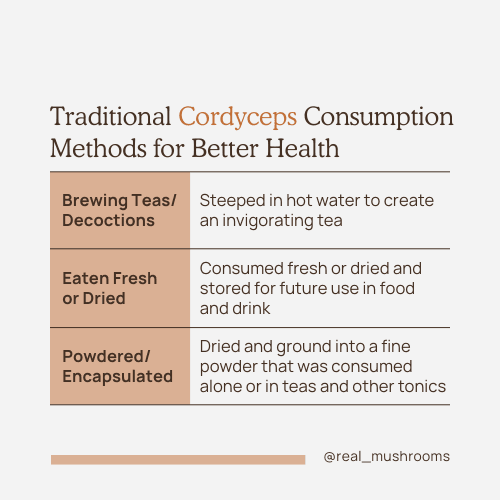
Various Cordyceps species held a special place in the healing traditions of Tibetan and Chinese medicine, where it was revered as a potent remedy for restoring vitality and supporting overall health.
Its’ use was particularly prized in high-altitude regions, where physical stamina and respiratory health were essential for human body survival. [3]
Traditional Chinese medicine remedies involving Cordyceps were often prepared in specific ways to maximize their perceived benefits:
In ancient practices, Cordyceps was ideal for the elderly and those recovering from illness. It was commonly prescribed to enhance stamina, delay aging, and maintain vitality, making it a favored remedy for enhancing male health and vigor.

As trade routes expanded and knowledge of natural remedies traveled the world, Cordyceps began to intrigue practitioners beyond China and Tibet.
While initially seen as exotic and mysterious, its medicinal properties and reputation as a tonic for energy and health slowly gained international traction in holistic health circles.
With the growth of Eastern medicine’s influence worldwide in the late 20th century, Cordyceps began gaining recognition in the West.
The 1993 Chinese National Games elevated its profile when a women’s running team broke nine world records, crediting their performance to high-altitude training and regular consumption of Cordyceps elixirs.

As Cordyceps entered the global wellness market, scientific research began to back many of the human health benefits observed for centuries. Studies have explored its potential to:
Cordyceps’ bioactive compounds, such as cordycepin, have drawn interest for their strong antioxidant properties [7], which may help protect human cell lines and promote overall wellness. This growing scientific validation has elevated it from a traditional remedy to a promising focus in modern health and biotechnology.
Today, Cordyceps has become a cornerstone of the functional mushroom industry. Its rich history and scientifically backed benefits have made it one of the most popular natural supplements worldwide.
As a parasitic fungus dependent on specific insect hosts and environmental conditions, Cordyceps faces significant challenges in a changing climate.
Rising temperatures and shifting ecosystems are altering insect habitats, forcing Cordyceps species like Cordyceps sinensis to adapt their life cycles, host preferences, and geographic ranges. [8]
Wild Cordyceps sinensis, already rare and overharvested, is particularly vulnerable as habitat loss in the Tibetan Plateau threatens its survival. This decline risks disrupting local ecosystems and economies that rely on its collection.
However, climate change also offers opportunities for research. Studying Cordyceps’ adaptability could uncover new insights for fungal conservation while advancing climate-resilient agricultural and functional applications [9], transitioning these fungi from wild harvesting to sustainable cultivation.

Cordyceps mushrooms have a long history in traditional medicine and are celebrated today for their ability to support energy, respiratory health, and overall vitality.
Real Mushrooms ensures you get the full benefits by using only 100% organic fruiting bodies—never grain fillers—for higher beta-glucans and maximum effectiveness. With third-party testing and a focus on transparency, their mushroom powders, extracts, and capsules are crafted to meet the highest standards.

As we embrace the new year, many of us set goals to improve our physical, mental, and emotional well-being. In 2025, the focus on health resolutions continues to grow, with trends like mindfulness, sustainable living, and natural health solutions taking center stage. Here's how mushrooms, nature’s versatile gems, can help you achieve your wellness aspirations this year.
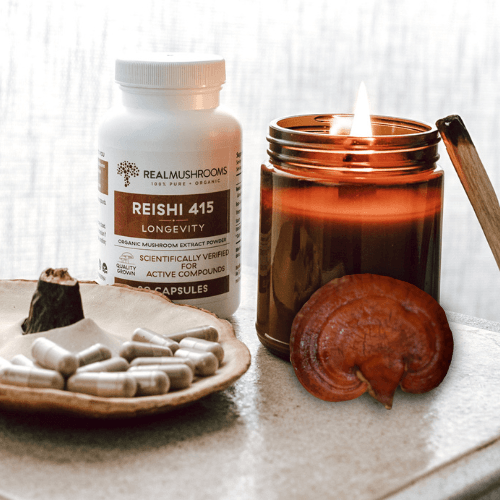
With the increasing complexity of our lives, achieving mental clarity is a top priority. The best-known mushroom for brain benefits is lion’s mane (Hericium erinaceus). However, there are other multi-functional mushrooms for supporting brain health, cognition, and mood. These mushrooms include reishi (Ganoderma lucidum) and cordyceps (Cordyceps militaris).

For those focusing on physical goals, mushrooms like cordyceps can support energy and endurance. Cordyceps have been used traditionally to enhance athletic performance and aid post-workout recovery. Add them to your smoothies or pre-workout routines to stay on top of your fitness game.
Fitness enthusiasts can benefit from incorporating mushrooms like cordyceps and reishi into their routines.

Did You Know? Compounds in cordyceps (primarily, cordycepin) can increase the availability of adenosine triphosphate (ATP), an energy-storage molecule. Since enhancing ATP production can have cognitive-enhancing effects, and overall anti-fatigue effects, cordyceps can be an ally for supporting focus and cognitive energy.
This year, activities that combine mindfulness and sustainability are in demand. Mushroom gardening—a beginner-friendly and rewarding hobby—is an excellent way to connect with nature, reduce stress, and grow your own food. Cultivating your own mushrooms can also be a sustainable way to enjoy fresh, nutrient-rich produce.
Immune health continues to be a priority, and functional mushrooms like reishi (Ganoderma lucidum) and turkey tail (Trametes versicolor) are among the most effective natural tools for supporting your body’s defenses. These mushrooms have been revered for centuries in traditional medicine and are now celebrated in modern wellness for their potent immune-modulating properties.

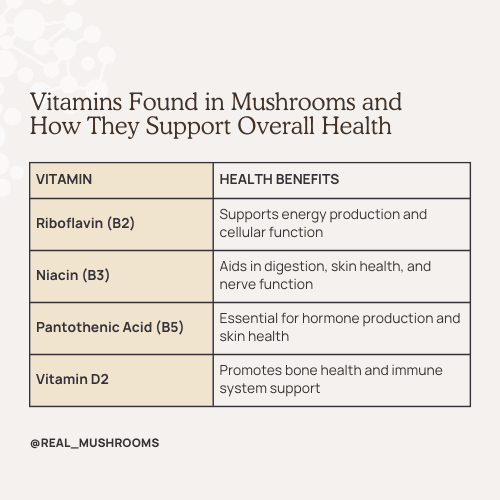
Cooking with mushrooms is a resolution that combines the joy of culinary exploration with nutritional health benefits. Mushrooms are incredibly versatile, offering a unique array of flavors and textures, from the meaty satisfaction of lion’s mane to the earthy richness of shiitake. Whether you’re a gourmet chef or a home cook, mushrooms can elevate your meals while supporting your healthy diet.
Protein:
Dried mushrooms, such as shiitake and oyster, can contain up to 30 grams of protein per 100 grams, rivaling many animal-based protein sources. Moreover, mushrooms are a complete protein source, containing all nine essential amino acids needed for optimal health and recovery. Since fresh mushrooms contain protein, have a dense texture and satisfying umami flavor, they make an excellent meat substitute and are ideal for keto diets.
Vitamins (B & D):
Fiber:
Mushrooms are an excellent source of dietary fiber, including beta-glucans, which promote gut health, improve digestion, and help regulate cholesterol levels. Their fiber content also contributes to feelings of fullness, making mushrooms a great addition to weight-management diets.
Antioxidants:
Functional mushrooms like reishi, chaga, and golden oyster contain high levels of antioxidants, including ergothioneine and glutathione. These compounds help protect cells from oxidative stress, modulate inflammatory markers, and support overall cellular health and longevity.
Explore our recipes to learn how easy and delicious it is to indulge in culinary creativity with fresh, dried, or extracted mushrooms.
Did You Know? Mushrooms are one of the only natural, non-animal-based sources of vitamin D! You can easily enhance the vitamin D content of mushrooms at home—just place them gill-side up in direct sunlight for a few hours before cooking!
As you set your intentions for 2025, consider incorporating mushrooms into your wellness routine. Whether it's through supporting your workouts, enhancing your diet, or boosting brain power, mushrooms offer a natural, versatile way to attain your personal goals.
Let this be the year you grow with mushrooms!
